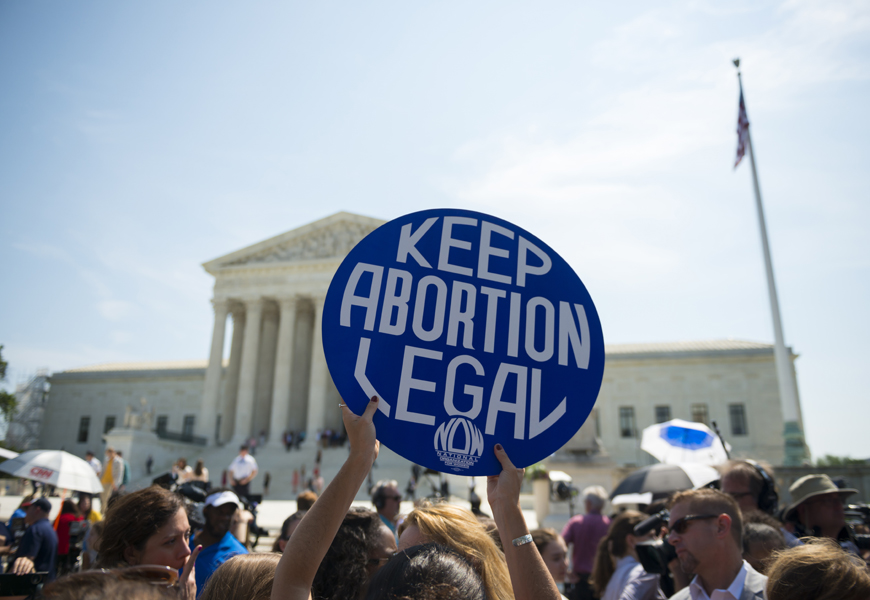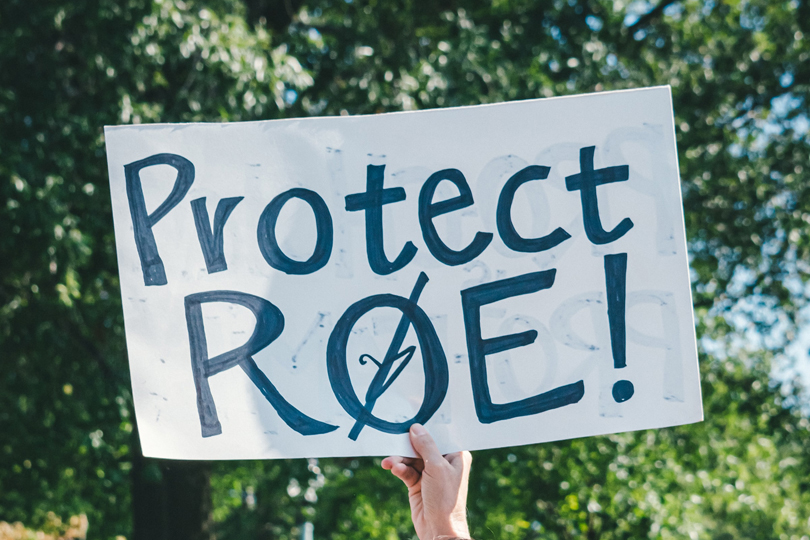The leak of an initial draft of a US Supreme Court decision that would overturn the landmark Roe v. Wade case has prompted immediate responses and emotions. The leaked draft opinion, written by Justice Samuel Alito and originally published by Politico on May 2, suggests that the majority of the nine justices in the country’s highest court may be ready to reverse the historic ruling, potentially allowing individual states to more heavily regulate or even ban abortions. (No final decision has yet been taken; the Supreme Court’s justices are expected to issue a ruling in late June or early July. Until a decision has been formally announced, any vote that has been taken by the justices can be reconsidered and no changes to current law may be made.)
A woman’s right to have an abortion through the first trimester of her pregnancy was protected throughout the United States in 1973, following the Supreme Court’s landmark 7–2 ruling in a court case known as Roe v. Wade. The impending move to overturn Roe would disrupt nearly 50 years of legal precedent and would impact millions of women and pregnant people, creating a ripple effect across the nation and around the world. To understand what is happening, it is worth breaking down and explaining the origins of Roe in simple, digestible terms.
What is Roe v. Wade?
“Roe” has become shorthand for the historic US Supreme Court case known as Roe v. Wade. First argued in 1971 and decided in 1973, the case examined whether the US Constitution recognizes a woman’s right to end her own pregnancy. Ultimately, the Supreme Court justices, by a 7–2 vote, decided that, yes, abortion is a constitutional right.
What was the pre-Roe landscape in the US?
At the time of Roe, abortion was broadly legal in just four states, and allowed under limited circumstances in 16 other states. Constitutional rights trump state laws, so the Supreme Court’s decision nullified the bans in the remaining 30 states. But it did allow states to impose certain regulations during the second trimester to protect the woman’s health, and take steps to protect fetal life in the third trimester.
What happened in this seminal case?
In June 1969, ‘Jane Roe’ (the fictional alias of a woman who was later identified as Norma McCorvey) became pregnant with her third child. She was 21 at the time, unmarried and unemployed, and sought to have an abortion in Texas, where it was illegal at the time except to save the life of the mother. Unable to have an abortion legally, she then sought to have an illegal abortion but was unsuccessful.
Several months into her pregnancy, she met attorneys Linda Coffee and Sarah Weddington, who filed a lawsuit on her behalf in US federal court against Henry Wade, then the district attorney of Dallas County. Roe’s lawyers said she was unable to travel out of the state to obtain a legal abortion and argued that the laws were “unconstitutionally vague and abridged her right of personal privacy, protected by the First, Fourth, Fifth, Ninth, and Fourteenth Amendments.”
In June 1970, a three-judge panel of the US District Court for the Northern District of Texas heard the case and ruled in favour of Roe, stating that the Texas law was unconstitutional because it violated the right to privacy covered in the Ninth Amendment, which broadly says that citizens are not restricted to only those rights listed in the Constitution.
Texas then appealed directly to the US Supreme Court. The initial arguments were heard in December 1971, and the case was re-argued in October 1972. The question before the Supreme Court was: Does the Constitution recognize a woman’s right to terminate her pregnancy by abortion?
Ultimately, the Supreme Court justices decided on January 22, 1973, that abortion is a constitutional right. The 7-2 majority opinion – written by Justice Harry A. Blackmun – argued that making abortion broadly illegal violates the due process clause of the Fourteenth Amendment, ensuring a citizen’s right to privacy. That clause reads, “[N]o State shall…deprive any person of life, liberty, or property, without due process of law,” in essence ensuring that states must respect the rights due to every individual American. Within the context of Roe v. Wade, a person’s bodily autonomy was considered part of their right to privacy. Excessive government regulation of a person’s body was determined to be unconstitutional.
“This right of privacy…is broad enough to encompass a woman’s decision whether or not to terminate her pregnancy,” the majority opinion stated. “The detriment that the State would impose upon the pregnant woman by denying this choice altogether is apparent.”
More specifically, the conservative-leaning court ruled that abortions should be treated differently at various points in a person’s pregnancy: in the first trimester, the justices said a woman’s decision to have an abortion must be left to her and her doctor. In the second trimester, a state may regulate abortion if such a regulation is “reasonably related to maternal health.” Finally, in the third trimester, once a fetus is “viable” – in other words, can survive outside the womb – states may regulate or prohibit abortion altogether, except in cases where the act is medically necessary to save a life.
Five Republican-nominated judges were among the majority.

What’s the current legal situation?
In 1992, the US Supreme Court heard Planned Parenthood v. Casey, a challenge to Pennsylvania abortion laws that included a 24-hour waiting period. The conservative-leaning court eventually affirmed that citizens hold a constitutional right to abortion under the Fourteenth Amendment, and upheld the right to abortion – albeit also making it easier for states to impose regulations.
It was a closer decision this time around – a 5–4 vote, compared to 7–2 in 1973. And given today’s situation, it’s important to remember that the decision in 1992 could have gone either way. Initially, five of the justices at the time actually voted to overrule Roe v. Wade, but then Justice Anthony Kennedy switched his vote, meaning a majority of the court reaffirmed a woman’s right to have an abortion.
At the time, three conservative justices – Sandra Day O’Connor, Anthony Kennedy and David Souter – co-authored the court’s majority opinion, writing: “The woman’s right to terminate her pregnancy before viability is the most central principle of Roe vs. Wade. It is a rule of law and a component of liberty we cannot renounce.”
The decision provoked a firestorm and since the ruling, some conservative states have chipped away at abortion rights with laws that have engendered many more court challenges.
What would overturning Roe mean for abortion access in the US?
Currently, abortion is legal in every state of the United States, though different states have enacted varying levels of restrictions. If Roe v. Wade were overturned, the question of abortion’s legality would be decided entirely by each individual state, and abortion could become outright illegal in numerous states.
The Center for Reproductive Rights, a human rights organization and pro-choice group, maintains a database called “What if Roe fell?” which predicts at least 25 states are expected to ban abortion altogether if Roe v. Wade is overturned. There are other potential consequences of Roe being overturned: past decisions on laws covering same-sex marriage, same-sex sexual activity, consensual sex and individual autonomy, including the right to access contraception, may be in danger.
The overturning of Roe v. Wade would also call into question the legitimacy of the Supreme Court, which is expected to maintain precedent (meaning the court is expected to base its rulings on – or at least be guided by – rulings that were made on previous, similar cases). Such precedent prevents landmark decisions from shifting every few decades, ensures that similar cases are treated equally rather than being based on individual judges’ personal views, and ensures governmental stability. But in a time of increasingly polarized politics, it seems unlikely that precedent will overcome the odds.
What would overturning Roe mean for Canada?
If Roe v. Wade were overturned, Americans could continue to receive abortions in Canada, according to Karina Gould, Canada’s minister of families, children and social development. The decision would affect people on both sides of the border.
Canada’s own top abortion rights case is the landmark 1988 R. vs. Morgentaler ruling. The Supreme Court of Canada struck down the federal law criminalizing abortion on January 28, 1988, and since that ruling, there have been no criminal laws regulating abortion in Canada.
While abortion is legal in this country, it is important to note that many Canadians do not have access to this procedure. It has been left up to the provinces to decide where people can access an abortion and what services are publicly funded through provincial healthcare plans.
Canada’s courts have not been plagued by the same kind of partisanship found south of the border. However, while strong pro-choice sentiment generally exists across Canada, that isn’t a protection against implementing laws and there is a possibility that the impending decision in the US might impact abortion rights across the country. Since Canada has no laws governing abortion, in theory, a political party could attempt to pass a new bill restricting abortion.
Still, it is unlikely that a Canadian government would attempt to make abortion illegal if Roe was overturned. However, such a decision could influence further restrictions in Canada. Restrictions already exist in some provinces, and some of those restrictions are already the subject of ongoing court challenges.











